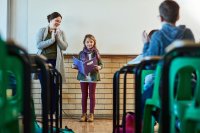A PBL Unit With Lessons for Teachers
A project-based learning unit that left students feeling unenthusiastic had valuable lessons for the teachers who prepared it.
While collecting hundreds of pieces of trash along the new bike path outside our elementary school’s playground, a group of my students noticed a lack of trash cans. They were outraged and immediately threw their energy into addressing this issue. They began a months-long project to collect data on the issue, and eventually decided to share their findings with an authentic audience.
In a comprehensive PowerPoint presentation (complete with graphs) at a town council meeting, six students made a strong argument for the installation of trash cans along the path. The mayor smiled, the council members clapped, and the audience gave a standing ovation. The council voted in favor of the project.
How We Got There
Pagosa Peak Open School utilizes project-based learning as a way to build not only content knowledge but also qualities such as confidence and collaboration. Putting students in front of the council for this project felt like it should hit all our goals: We’d follow the interests of the students, support their innate desire to care for their environment, and provide them with opportunities to work together and build confidence.
In addition, the staff was eager to see the students in front of the community. This was a new school, and having students present their work would say something positive about us as teachers, too.
Before going to the town council meeting—which students said made them nervous—they first took their ideas to another elementary school and asked students there to participate in their clean-up efforts. Later, the students also presented their ideas at our school in front of parents, staff, and the town’s parks and recreation director. With these two presentations under their belts—one with a familiar audience and one in a familiar environment—I assumed they were ready for the council meeting.
I now know they were not.
The Aftermath of the Council Meeting
The day after the council meeting, I asked the students, “How are you feeling about this project?” They shrugged and looked away. One child offered an unenthusiastic “good.” It was clear that our opinions were not matching up. Pride was something I felt for them—not something they felt for themselves. As we talked, they revealed that they felt patronized and credited being “cute little kids” as the reason for the council’s vote.
“I know the council people were not listening because they were smiling the whole time,” Arya, 6, said.
And months later, Carlo, 9, told me, “Kids are easier to talk to. They take you seriously, they’re respectful. They actually listen.”
Being a grown-up myself, I had forgotten the importance of preparing my students for interactions in an adult world. I should have told them, “Most adults will think you are cute. You will exceed most adults’ expectations. And this will look like smiling, laughing, clapping, and hugging.”
So I was part of the problem. I saw the signs of condescension in the audience and didn’t realize that my students could see them too. My eagerness to positively impact the school’s image was a barrier to recognizing that there were more appropriate ways, such as writing letters to the council or editorials for the newspaper, to empower these students and help them share their learning.
Other Lessons We Teachers Learned
I also learned the importance of reflection during project work: Had we skipped the step of reflecting the day after the meeting, I would have made many incorrect assumptions. The reflection period prompted teachers to spend time considering student perspective and to ask, “Are we following their agenda or ours?”
I realized that while students need practice making their voices heard, adults need practice listening to them: Preparing adults for children is just as important as the reverse. If we’d prepared the council members to expect a serious presentation, the experience would have been much richer for the students because the council members could have asked them the questions they’d ask anyone else who was requesting that the town allocate funds and labor for a project.
In order to help children learn authentically, teachers should provide material, emotional, and environmental supports after first having in-depth conversations with their students and connecting children with the resources they seek. Crucially, they also need to truly believe that students’ goals are attainable.
Since the end of this project, our students have begun tackling another big issue in our town: food security. They have shared produce they grew in their garden with the food bank, hosted and cooked a free community meal for 200 people, and created a student board responsible for soliciting food security proposals from youth in the county.
The lessons learned from our time in front of the town council are not missed in our current work, as student efforts are continually put in front of community members. Preparing students for these interactions is now a part of all of our PBL experiences. Together we’re identifying our boundaries and expectations for ourselves and others—while we continue pushing for positive change in our community.
